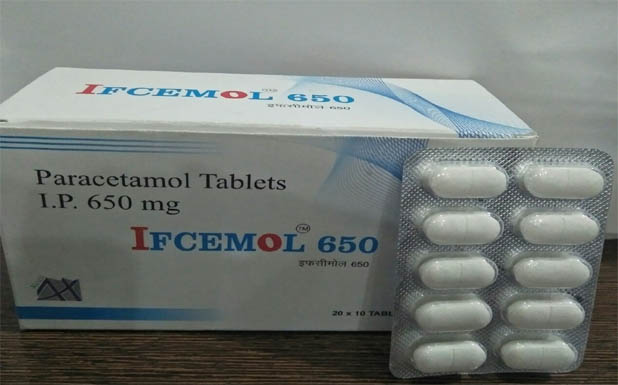
Composition
- Each Uncoated Tablet Contains:
- Paracetamol IP
650 mg
Packing
- 10x10
(Blister)
MRP
- 18.50
Overview
Paracetamol or Acetaminophen belongs to a group of medicines known as non-opiate, analgesic and antipyretic, or painkillers. It is used to relieve Mild-Tomoderate Pain. It is also useful for lowering a raised temperature (fever). Acetaminophen is used to treat many conditions such as headache, muscle aches, arthritis, backache, toothaches, colds, and fevers.
Indications
- For the treatment of mild to moderate pain including headache, migraine, neuralgia, toothache, sore throat and dysmenorrhea.
- For the symptomatic relief of rheumatic and muscular aches and pains sciatica, fibrositis, lumbago, joint swelling and stiffness.
- For symptomatic relief of influenza, feverish colds and feverishness.
Mechanism of Action
Paracetamol is an effective analgesi c and antipyretic agent but has only weak anti-inflammatory properties. It has been suggested that it may act predominantly by inhibiting prostaglandin synthesis in the CNS and to a lesser extent through a peripheral action by blocking pain-impulse generation. The peripheral action may also be due to inhibition of prostaglandin synthesis or to inhibition of the synthesis or actions of other substances that sensitize pain receptors to mechanical or chemical stimulation.
Paracetamol probably produces an antipyretic action by a central effect on the hypothalamic heat-regulating centre to produce peripheral vasodilation resulting in increased blood flow through the skin, sweating and heat loss. The central action probably involves inhibition of prostaglandin synthesis in the hypothalamus. The drug has no effect on the cardiovascular and respiratory systems, and unlike salicylates it does not cause gastric irritation or bleeding.
Pharmacokinetics
Absorption:Paracetamol is Readily absorbed from the gastro-intestinal tract with peak plasma concentrations occurring about 30 minutes to 2 hours after ingestion. Distribution:Present in most body tissues; crosses the placenta and enters the breast milk. Plasma-protein binding is negligible at usual therapeutic concentrations but increases with increasing concentrations. Metabolism: Hepatic via glucuronic and sulphuric acid conjugation. At normal therapeutic levels, glucuronide metabolites are metabolised to reactive intermediate (acetylimidoquinone) which is conjugated with glutathione and inactivated; at toxic doses, glutathione conjugation is insufficient leading to increased acetylimidoquinone which may cause hepatic cell necrosis. Excretion:It is metabolized in the liver and excreted in the urine mainly as the glucuronide and sulphate conjugates. Less than 5% is excreted as unchanged paracetamol. The elimination half-life varies from about 1 to 4 hours.Contraindications
Hypersensitivity to paracetamol or any of the constituents.
Precautions
Care is advised in the administration of paracetamol to patients with severe renal or severe hepatic impairment. The hazards of overdose are greater in those with non-cirrhotic alcoholic liver disease.
- Do not exceed the stated dose.
- Do not take with any other paracetamol-containing products.
- If symptoms persist for more than 3 days or get worse consult your doctor.
- Immediate medical advice should be sought in the event of an overdose, even if you feel well.
Side Effects
- Nausea
- Allergic reactions
- Skin rashes